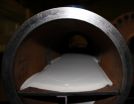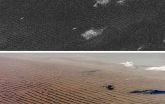(Press-News.org) Titan, Saturn's largest moon, is a peculiar place. Unlike any other moon, it has a dense atmosphere. It has rivers and lakes made up of components of natural gas, such as ethane and methane. It also has windswept dunes that are hundreds of yards high, more than a mile wide and hundreds of miles long--despite data suggesting the body to have only light breezes.
Research led by Devon Burr, an associate professor in the Earth and Planetary Sciences Department at the University of Tennessee, Knoxville, shows that winds on Titan must blow faster than previously thought to move sand. The discovery may explain how the dunes were formed.
The findings are published in the current edition of the academic journal Nature.
A decade ago, Burr and other scientists were amazed by the Cassini spacecraft's pictures of Titan that showed never-before-seen dunes created by particles not previously known to have existed.
"It was surprising that Titan had particles the size of grains of sand--we still don't understand their source--and that it had winds strong enough to move them," said Burr. "Before seeing the images, we thought the winds were likely too light to accomplish this movement."
The biggest mystery, however, was the shape of the dunes. The Cassini data showed that the predominant winds that shaped the dunes blew from east to west. However, the streamlined appearance of the dunes around obstacles like mountains and craters indicated they were created by winds moving in exactly the opposite direction.
To get to the bottom of this conundrum, Burr dedicated six years to refurbishing a defunct NASA high-pressure wind tunnel to recreate Titan's surface conditions. She and her team then turned up the tunnel's pressure to simulate Titan's dense atmosphere, turned on the wind tunnel fan, and studied how the experimental sand behaved. Because of uncertainties in the properties of sand on Titan, they used 23 different varieties of sand in the wind tunnel to capture the possible sand behavior on Titan.
After two years of many models and recalibrations, the team discovered that the minimum wind on Titan has to be about 50 percent faster than previously thought to move the sand.
"Our models started with previous wind speed models but we had to keep tweaking them to match the wind tunnel data," said Burr. "We discovered that movement of sand on Titan's surface needed a wind speed that was higher than what previous models suggested."
The reason for the needed tweaking was the dense atmosphere. So this finding also validates the use of the older models for bodies with thin atmospheres, like comets and asteroids.
The discovery of the higher threshold wind offers an explanation for the shape of the dunes, too.
"If the predominant winds are light and blow east to west, then they are not strong enough to move sand," said Burr. "But a rare event may cause the winds to reverse momentarily and strengthen."
According to atmospheric models, the wind reverses twice during a Saturn year which is equal to about 30 Earth years. This reversal happens when the sun crosses over the equator, causing the atmosphere--and subsequently the winds--to shift. Burr theorizes that it is only during this brief time of fast winds blowing from the west that the dunes are shaped.
"The high wind speed might have gone undetected by Cassini because it happens so infrequently."
INFORMATION:
This research was supported by grants from NASA's Planetary Geology
and Geophysics Program and the Outer Planets Research Program. A new grant will allow Burr and her colleagues to examine Titan's winds during different climates on Titan as well as the effect of electrostatic forces on the sand movement.
Burr's team included UT Earth and Planetary Sciences Assistant Professor Josh Emery as well as colleagues from the Johns Hopkins University Applied Physics Laboratory, SETI Institute, Arizona State University, and the University of California, Davis.
New nanopore DNA sequencing technology on a device the size of a USB stick could be used to diagnose infection - according to new research from the University of East Anglia and Public Health England.
Researchers tested the new technology with a complex problem - determining the cause of antibiotic resistance in a new multi-drug resistant strain of the bacterium that causes Typhoid.
The results, published today in the journal Nature Biotechnology, reveal that the small, accessible and cost effective technology could revolutionise genomic sequencing.
Current technology ...
For a small percentage of cancer patients, treatment aimed at curing the disease leads to a form of leukemia with a poor prognosis. Conventional thinking goes that chemotherapy and radiation therapy induce a barrage of damaging genetic mutations that kill cancer cells yet inadvertently spur the development of acute myeloid leukemia (AML), a blood cancer.
But a new study at Washington University School of Medicine in St. Louis challenges the view that cancer treatment in itself is a direct cause of what is known as therapy-related AML.
Rather, the research suggests, ...
BOSTON and CAMBRIDGE -- The genetic tumult within cancerous tumors is more than matched by the disorder in one of the mechanisms for switching cells' genes on and off, scientists at Dana-Farber Cancer Institute and the Broad Institute of MIT and Harvard report in a new study. Their findings, published online today in the journal Cancer Cell, indicate that the disarray in the on-off mechanism - known as methylation - is one of the defining characteristics of cancer and helps tumors adapt to changing circumstances.
The researchers also showed that derangement in ...
BOSTON -- Small cell lung cancer - a disease for which no new drugs have been approved for many years - has shown itself vulnerable to an agent that disables part of tumor cells' basic survival machinery, researchers at Dana-Farber Cancer Institute and the Massachusetts Institute of Technology reported.
In a study published today in the journal Cancer Cell, the investigators found that the agent THZ1 caused human-like small cell lung tumors in mice to shrink significantly, with no apparent side effects. The compound is now being developed into a drug for testing ...
COLUMBUS, OH - As interest in organic agricultural and horticultural practices continues to grow, so does the need to identify alternative weed control practices. Mulching, a common practice used to control weeds and reduce the need for tillage, can also reduce insect pollinators' exposure to harmful pesticides; however, finding the right mulch materials that allow pollinators to flourish can be challenging. Caitlin E. Splawski, from The Ohio State University Department of Horticulture and Crop Science, researched the effects of several types of organic mulch on squash ...
WASHINGTON, Dec. 8, 2014 -- There's probably a box of it in your fridge or cupboard, and it has a million uses: baking soda. Reactions is back with volume four of its popular Chemistry Life Hacks series, with tips on how to de-skunk your dog, clean your kitchen and supercharge your washing machine. Check out the latest in the series that's one-part MacGyver, one-part Mendeleev here: http://youtu.be/85diRmuk-ow.
Subscribe to the series at Reactions YouTube, and follow us on Twitter @ACSreactions to be the first to see our latest videos.
The American Chemical Society ...
Nearly half of all children in the United States are exposed to at least one social or family experience that can lead to traumatic stress and impact their healthy development - be it having their parents divorce, a parent die or living with someone who abuses alcohol or drugs - increasing the risk of negative long-term health consequences or of falling behind in school, suggests new research led by the Johns Hopkins Bloomberg School of Public Health.
The study reports on new data showing the magnitude of these adverse experiences in the child population in the U.S., ...
Voters are more willing to pay for a decreased risk of food-related illness than consumers, but female consumers are more willing to pay than male consumers, according to an international team of researchers.
"The question is, what would consumers prefer?" said Amit Sharma, associate professor of hospitality management and finance, Penn State. "Would they prefer a market-driven, or a policy-driven approach? Either of those two approaches could lead to some price increase. Improving quality costs money, and food safety is no different."
Sharma and colleagues wanted to ...
In the days shortly after giving birth, most mothers experience a period of increased calmness and decreased stress responses, but around 20% of mothers experience anxiety. Some women may become depressed, and around one in a thousand can develop psychosis. The latest evidence indicates that these distressing responses to motherhood are still poorly understood, but that animal research could provide valuable clues to their causes.
Writing in the British Journal of Pharmacology, Dr David Slattery and Dr Clara Perani highlight that anxiety, depression and psychosis during ...
Wind turbine developments have no effect on property values of nearby homes and farms, according to new research from the University of Guelph.
Published in a recent issue of the Canadian Journal of Agricultural Economics, the study is believed the first peer-reviewed study on this issue in Canada.
It was conducted by Richard Vyn, a professor in the Department of Food, Agricultural and Resource Economics, and Ryan McCullough, a former U of G graduate student and now a policy analyst for Health Canada.
They analyzed more than 7,000 home and farm sales in Melancthon ...





